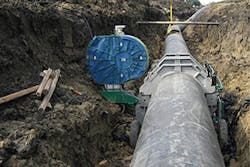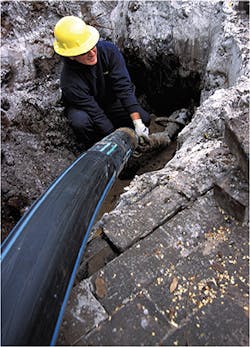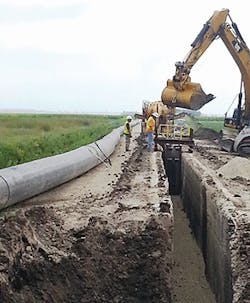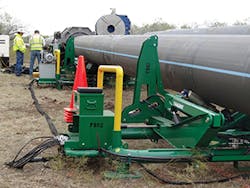Addressing Water Infrastructure with Pipe Innovation
Recent American Water Works Association (AWWA) studies conclude that America is currently in an era of pipe replacement, points out Lawyer Jolley, general manager of Performance Pipe, a division of Chevron Phillips Chemical Company.
“With more than one million miles of water piping in the United States, much of which was installed more than 50 years ago, there is a critical need to replace pipe that has reached or is near the end of its useful life,” says Jolley, adding that two of the biggest issues with existing water infrastructure are corrosion and leakage.
Pipe in stone hole
In addressing water infrastructure, “we talk about the old pipe and how the pipe that was made 100 years ago is not the same pipe as we make today,” points out Gregg Horn, vice president in charge of technical services for the Ductile Iron Pipe Research Association (DIPRA). “The metallurgy and manufacturing techniques have improved,” he says. “Today, we do internal pressure loadings as well as external loadings for earth and traffic loadings, and we know how to control erosion.
“One hundred years ago, for example, we didn’t have 18 wheelers, so that pipe was put in the ground without the benefit of that type of engineering. We have asked that pipe to do a heck of a lot that it was never conceived of having to deal with, including inside and outside corrosioncontrol in that era.”
Horn recently pointed out to a group of US mayors gathering for a meeting that while the industry has been focusing on pipe that is going into the ground in the future, “we forget sometimes about the older pipe and the problems it can present. But we’re doing a better job.”
Flint, MI’s lead-in-water crisis sharpened the focus on the aging infrastructure. As water utilities conduct condition assessments and make moves to repair or replace pipe, today’s choices present a number of innovations designed to address the many challenges facing water transmission.
One key area of innovation is in the use of newer materials that provide more cost-effective solutions, Jolley points out.
“High-density polyethylene [HDPE] pipes have been available for 50 years, used extensively in gas distribution, mining, and industrial project applications,” he says. “Today, innovation is coming in the form of utilities that are now taking advantage of the benefits that HDPE pipes provide as a solution to leakage and corrosion in existing aged municipal infrastructure.”
“With the pipe’s leak-tight fusion joints and corrosion resistance, as well as trenchless installation options that HDPE pipes make achievable, HDPE piping has become a more cost-effective solution for utilities overall.”
“Polyethylene physical properties can be adjusted through the design of the polymer architecture,” says Jolley. “This is accomplished through the use of copolymers, specialized catalysts, and resin production technology.”
A new grade of HDPE piping materials described as PE4710 pipe resins were introduced in the AWWA water transmission and distribution standards in 2015, Jolley points out. “PE4710 pipe resins have increased toughness to resist loads and damage, and they are rated to provide a 25% higher pressure rating for the same size pipe without reduction to the pipeline system safety.
“This change in the AWWA standard allows utilities to take advantage of the durability and reliability of HDPE pressure pipes while also making HDPE pipe a more cost-competitive choice,” he adds.
Chevron Phillips Chemical Company is constructing a 1.1-billion-pound bimodal polyethylene reactor on the US Gulf Coast that will be capable of producing PE4710 pipe resins. Startup of the US Gulf Coast petrochemicals project is expected in mid-2017.
The HDPE heat-fused joint has been at the heart of HDPE’s success as a pipeline, notes Jolley. “While mechanically connected joints and mechanical fittings are an important part of any pipeline, the tensile strength and the strain capability of the HDPE fusion joint have led to its reliability and success in applications,” he adds.
Jolly points out that recent advancements in the development of the fusion procedure for HDPE pipes include:
- The addition of polyethylene fusion into ASME BPV section 9, which has been retitled “Welding, Brazing, and Fusing” in recognition of HDPE fusion
- ASTM standard F3124 for the practice of Data Recording of field fusion joints
- The recently approved ASTM standard practice for Operator Qualification
- The ASTM standard test for field fusions called the “Side Bend” tester.
“These procedures—along with existing ASTM standard fusion procedure for HDPE—provide the utility with the confidence to specify the fusion method, including training requirements and quality control procedures,” adds Jolley.
Seismic resistance is another concern regarding water pipe infrastructure. “Analysis of pipeline damage after significant earthquakes has shown that polyethylene pipe provides significant resistance to both transient and permanent ground deformation,” says Jolley. “This was projected to be a benefit of HDPE pipeline due to the large strain tolerance of both the pipes and the heat-fused joint.
“Both polyethylene and the HDPE heat-fused joints can withstand short-term strains of 8% and a design allowance of 3% for long-term strain.”
Jolley points out recent studies of earthquakes have demonstrated that the tensile strain resistance of HDPE pipes prevented pipeline damage from seismic activity.
One of the original methods of installing HDPE pipes was to slip-line, or insert the pipe inside an existing pipeline, says Jolley. Pipe bursting involves sending blades to cut through the older host pipe and inserting an HDPE pipeline in its place that is of a larger diameter.
“The smooth flow characteristics of the interior of the HDPE pipe often made it possible to match or increase the flow rate with the reduced diameter,” he says. “Today’s technology allows larger-diameter HDPE pipes to replace smaller-diameter aging pipelines utilizing pipe bursting technology.”
Weaver Project was a 30-inch x 17 DIPS main water line-to-plant installation.
In one instance, the city of Austin, TX, needed to increase the water capacity to its burgeoning population. The city used pipe bursting to replace 6-inch cast iron pipes with 10-inch HDPE pipes, “which significantly reduced the cost of the installation and the disruption to the neighborhoods that would be caused by traditional open cut burial methods,” points out Jolley.
Pipe bursting is also designed to be a more cost-effective alternative to abandonment of Asbestos-Cement (AC) pipelines, says Jolley.
“The Water Research Foundation published a report in 2015, the ‘Environmental Impact of Asbestos Cement Pipe Renewal Technologies,’ which in part assessed pipe bursting using PE4710 HDPE pipes,” he says.
“The report found that there was no negative impact on the air quality, that the method did not adversely impact soil environment, and had no negative impact on the water quality,” he adds. “The method and use of PE4710 HDPE pipes offers utilities a cost-effective and environmentally secure method to replace AC pipelines, many of which have reached the end of their designed service life.”
HDPE pipes and the HDPE fusion joint have been used “very successfully” in directional drilling applications, says Jolley.
“The strength and flexibility of HDPE pipes allow the pipes to be deflected to a tighter bend radius than the drill rod. This provides additional confidence to the utility that the pipe won’t see damage from over-deflection,” he says. “Additionally, HDPE pipes can be tapped on a bend with no concerns of cracking, providing further assurance to the utility regarding the integrity of its pipeline.”
A San Antonio Water System wellfield in 2012
The Performance Pipe company was recently recognized by the Plastics Pipe Institute for its “Project of the Year,” a competition that highlights the installation and use of plastic piping products in unique ways through scale, scope, or innovation.
The project, “Regional Carrizo Water Project, San Antonio Water System” (SAWS), involved the installation of 122,149 feet of various-sized pipe for the purpose of transporting 13 million gallons per day (MGD) of water from a well field to an integration point in northeast San Antonio, where it enters the SAWS distribution system.
The project was designed to assist in diversifying San Antonio’s water supply, reducing dependence on the existing Edwards Aquifer supplies, as well as to provide water to help meet San Antonio’s short- and mid-term water needs, beginning in late 2013.
While the project was initially specified for steel pipe and ductile iron, concerns over the corrosive nature of the groundwater led to the choice of HDPE. More than 11 million pounds of material and more than 23 miles of large-diameter polyethylene pipeline were used in the project.
While corrosive pipes in Flint, MI, turned the spotlight on pipe materials and related factors, “it’s a situation that is obviously not limited to Flint—it’s all over the place,” notes Tony Radoszewski, president of the Plastics Pipe Institute.



